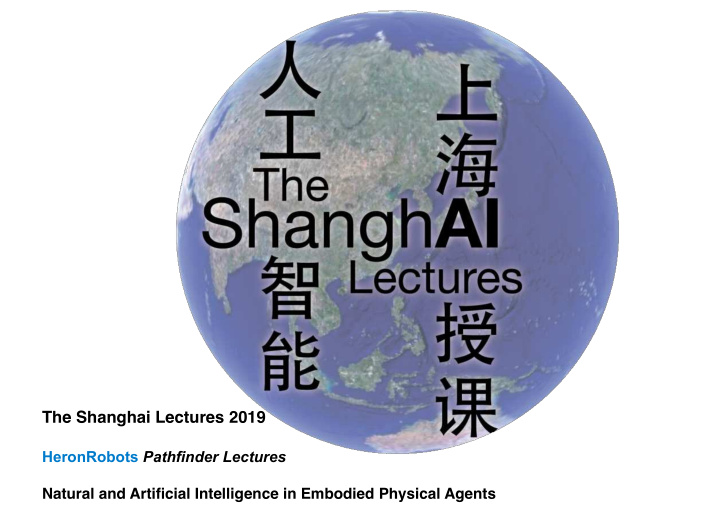



The Shanghai Lectures 2019 HeronRobots Pathfinder Lectures Natural and Artificial Intelligence in Embodied Physical Agents
欢迎您参与 The ShanghAI Lectures An experiment in global teaching Fabio Bonsignorio The ShanghAI Lectures and Heron Robots “ 来⾃臫上海渚的⼈亻⼯左智能系列劣讲座 ”
Lecture 3 Emerging Intelligence: Cognition from Interaction, Development and Evolution 21 November 2019
Today’s topics brain-in-a-vat • short recap • self-organization at many levels • self-organization and emergence in groups of • agents modular robotics and self-assembly • design principles for collective intelligence •
“Brain-in-a-vat” Alva Noë, “Out of our heads - why you are not your brain”, New York, Hill and Wang, 2009 6
Short recap given robot evolve control (neural • network) embodied approach co-evolution of • morphology and control
Evolving morphology and control: Karl Sims’s
New version: Golem (Lipson and Pollack) representation of morphology in genome • robot: bars, actuators, neurons • bars: length, diameter, stiffness, joint type • actuators: type, range • neurons: thresholds, synaptic strengths (recursive encoding) 9
Genetic Regulatory Networks (GRNs): Bongard’s “block development (morphogenesis) embedded • into evolutionary process, based on GRNs testing of phenotypes in physically • realistic simulation 10
Bongard’s evolutionary scheme genotype: parameters of genetic regulatory network reproduction: ontogenetic development: mutation and “transcription recombination factors” phenotype selection: physically realistic simulation
Representation of “gene” nc: “non-coding region” nc nc nc nc nc G1 G2 G3 G4 G1, G2, …: “genes” on “genome ” TF: “transcription factor” nc nc Pr P1 P2 P3 P4 P5 nc nc 0.14 0.31 0.03 0.81 0.08 0.03 0.23 0.74 0.24 0.39 P1 P2 P3 P4 P5 TF37 TF2 0.03 0.23 0.74
Limitations of artificial evolution? think about: Where are the limits of artificial evolution? Or is the potential unlimited?
Collective intelligence
Self-organization and emergence at many levels molecules • cells • organs • individuals • groups of individuals •
collective intelligence Time perspectives
Time perspectives in understanding and design collective intelligence state-oriented “here and now” perspective “hand design” learning and “ontogenetic” perspective development initial conditions, learning and developmental processes “phylogenetic” perspective evolutionary evolutionary algorithms, Understanding: all three perspectives requires Design: level of designer commitments, relation to autonomy Collective intelligence: emergence from interaction
Examples of collective behavior — self-organization bee hive “wave”in stadium termite mound open source development community
Examples of collective behavior — self-organization bee self-organization: groups of hive “wave”in stadium individuals termite mound open source development community
Recall: Emergence collective behavior: global patterns from local • interactions (e.g. “Swiss Robots”, bird flocks, clapping) behavior of individual: emergent from • interaction with environment from time scales •
Swarm behavior birds humans insects sheep fish 21
Craig Reynolds’s flocking rules Flocking: the “Boids” 1. 2. 3.
Craig Reynolds’s flocking rules Flocking: the “Boids” 1. Collision avoidance: Avoid collisions with nearby flockmates (and other objects) 2. Velocity matching: attempt to match velocity of nearby flockmates 3. Flock centering: attempt to stay nearby flockmates
Problem to think about: Modeling swarm behavior frame-of-reference? situated vs. “god’s eye view” “god’s eye view”: straightforward situated view: biologically more plausible but more difficult to implement
Design principles for collective systems Principle 1: Level of abstraction Principle 2: Design for emergence Principle 3: From agent to group Principle 4: Homogeneity/heterogeneity
Assignments for next week Check “How the body…” for self-study • Think about how to design a simulation model • for flocking from a situated perspective
End of lecture 3 Thank you for your attention! stay tuned for lecture 4
Recommend
More recommend